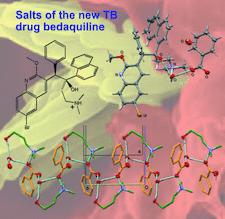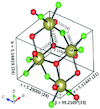issue contents
November 2020 issue

Cover illustration: The single-crystal structures of three salts (fumarate and two new benzoate) of bedaquiline, a drug used for the treatment of drug-resistant tuberculosis (TB), are described. These will help in improving the properties of such salts, such as solubility, which in turn affect pharmacokinetics and dosage. The study also aimed to find a bedaquiline salt with improved stability and hygroscopicity. See Okezue, Smith, Zeller, Byrn, Smith, Bogandowich-Knipp, Purcell & Clase [Acta Cryst. (2020), C76, 1010-1023].
research papers
A novel polymorph of (E)-4-bromo-2-[(phenylimino)methyl]phenol is reported, with a dihedral angle between the planes of the two aromatic rings of 45.6 (1)°, significantly different to that of the previously published polymorph. The structure contains an intramolecular O—H⋯N hydrogen bond forming an S(6) ring.
A novel complex has been prepared using the (E)-4-nitro-N-(pyridin-2-ylmethylidene)aniline bidentate Schiff base ligand and PtCl2. The neutral molecules form a one-dimensional chain structure through C—H⋯Cl and C—H⋯O hydrogen bonds. DPPH and ABTS inhibition studies revealed that the compound is proficient in donating electrons or H atoms and subsequently terminating chain reactions in a dose-dependent manner.
The single-crystal structures of three salts of bedaquiline, a drug used for the treatment of drug-resistant tuberculosis (TB), are described.
Two new CdII MOFs based on 1,4-bis(1H-benzimidazol-1-yl)butane and pimelate/sebacate (Pim/Seb) mixed ligands have been synthesized under hydrothermal conditions. Structure analysis reveals that the Pim MOF is a 2D sql layer structure containing a (H2O)8 water cluster. The Seb MOF shows an 8-connected hex supramolecular structure based on the hxl layer. Luminescence sensing studies reveal that both MOFs have good selectivity and sensitivity for the detection of the Fe3+ cation in water.
This work reports the precise crystal structure parameters of monoclinic hafnia (HfO2) and its validation from first-principles calculations. Complementary synchrotron X-ray and neutron diffraction experiments were performed and it was observed that the high-resolution neutron diffraction data significantly improves the precision of the constituent O-atom positions in bulk HfO2 relative to that obtained from earlier X-ray diffraction studies.



 access
access



 access
access





 journal menu
journal menu






















